Reproduction and Modification in Plants | Term 1 Unit 5 | 7th Science - Sexual reproduction | 7th Science : Term 1 Unit 5 : Reproduction and Modification in Plants
Chapter: 7th Science : Term 1 Unit 5 : Reproduction and Modification in Plants
Sexual reproduction
Sexual reproduction
Seed is produced from a flower by the process of pollination and fertilization. This is known as sexual reproduction. To understand how seeds are formed in a flower, first we need to understand parts of a flower.
ACTIVITY 2
Take a flower. Dissect as shown longitudinally and find parts inside the flower. Can you identify the male reproductive part, androecium (stamen, filament and pollen sac). Carefully observe the female reproductive part, gynoecium (ovary, style and stigma). If they are not seen clearly, gently pluck off the sepals and petals. Make a drawing of the parts and arrangement in your notebook.
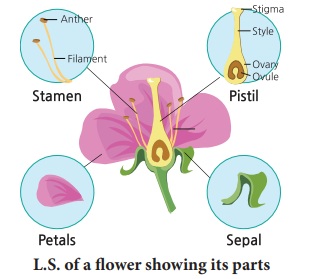
1. Parts of flower
Collect few buds and opened flowers of Hibiscus and Datura. With the help of yourteacher, perform the following steps.
i. Observe and compare bud and opened flower of Hibiscus and Datura.
ii. Tabulate the characteristics
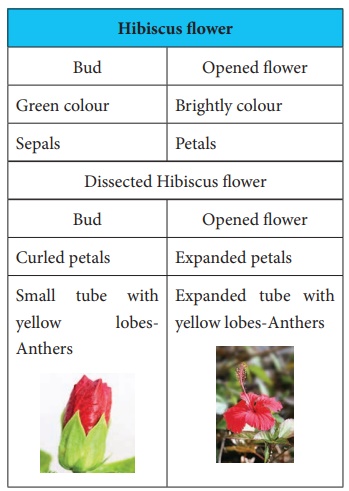
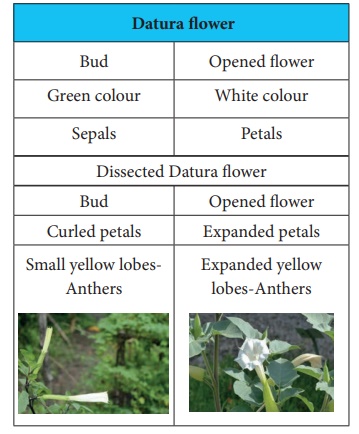
In a bud, we can see a green colour, leaf like structure which cover the whole bud or flower, Each of these green like structure present as an outermost layer is called as sepal. This outer most ring of sepals is known as calyx.
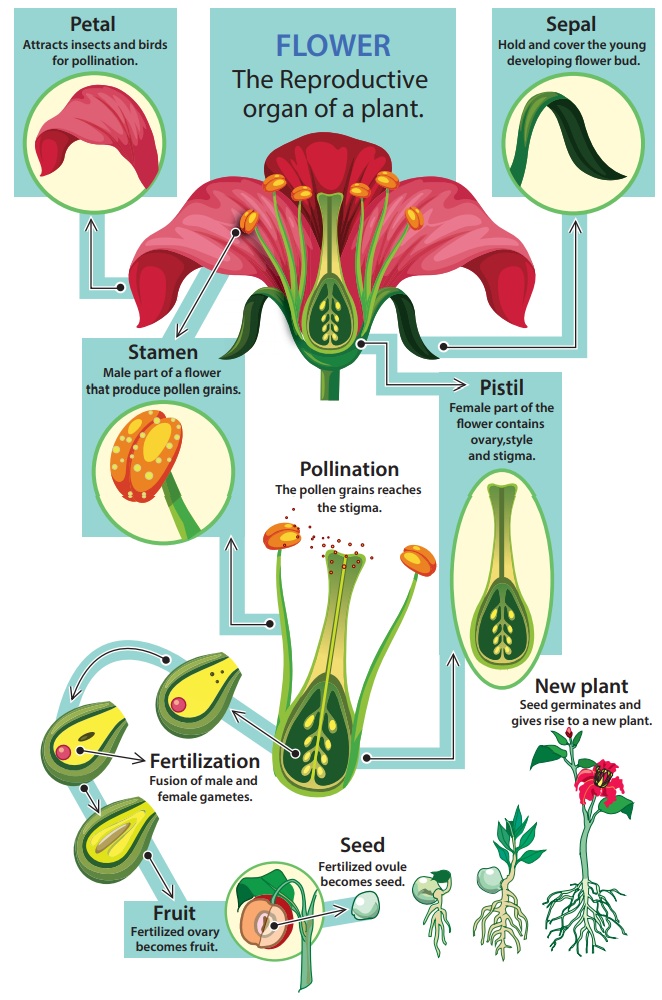
Petals are the largest part of flowers. They are often attractive, brightly coloured, sometimes sweet scented and attract the insects. This ring of petals together is called corolla.
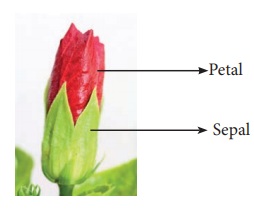
Inner to this corolla, in Hibiscus, we can observe a long tube on which many stamens are arranged. But in Datura, we can see only five stalked structures, stamens. This ring or whorl of a flower is called androecium. Each stamens consists of two parts – a stalk called filament and a lobe called anther. If you touch these lobes in a mature flower, we can get a powdery substance called pollen grains, male reproductive part.
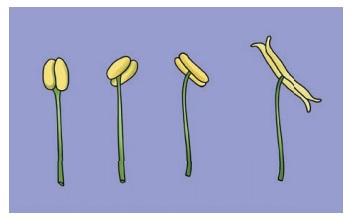
Androecium -Male part of the flower
Inner to this androecium whorl, we can find a female reproductive part of the flower, called Gynoecium. You will find this part with a swollen bottom part. This is the ovary. Seeds are produced in this part. On top of the ovary there is a slender tube like structure called style. The top most sticky tip of the style is stigma. Pollen grains are received by the stigma. This is the fourth whorl of a flower.
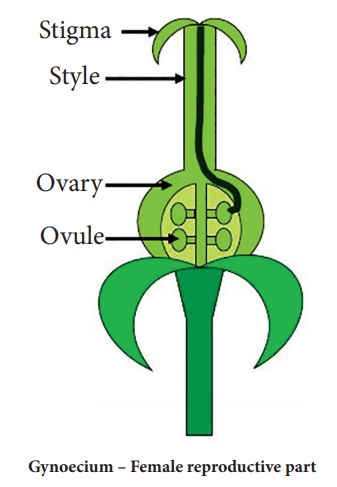
2. Types of flowers
Now we shall learn some important terms to understand flowers and their role in reproduction.
* If all the four whorls- calyx, corolla, stamens and pistil are present, then it is called as complete flower.
* Complete flowers are bisexual flowers.
* If any of these four whorls is missing, then it is called as an incomplete flower.
* Incomplete flowers are unisexual flowers. There are two types of unisexual flowers, male flower and female flower
* The one with androecium and without gynoecium is called as male flowers and the one with gynoecium and without androecium is known as female flowers.
* These are called unisexual flowers.
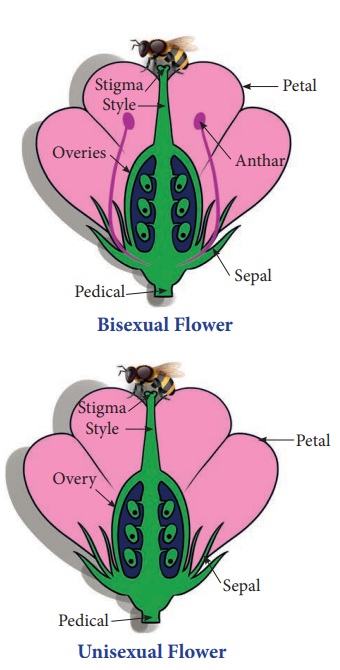
ACTIVITY 3
Using the information from the above complete the following table:


The sunflower is not asingle flower. It is a group of flowers clustered together. A group of flowers arranged together is called inflorescence. Tridax procumbens, looks like a single flower, but is an inflorescence. Leaf juice of this plant is used to cure wounds and cuts.
3. Flower to fruit
To understand how a flower develops into fruit, let us perform an experiment on pumpkin plant. We know from our earlier explorations that flowers of pumpkin are unisexual- that is some of the flowers are male while many are female flowers.
ACTIVITY 4
Make a flower album
Press the collected flowers between pages of newspaper or book. Place two thick sheets and keep a heavy object, such as brick, on the top to apply pressure. Turn the sides every two to three days. Allow flowers to dry completely. Collect the dried flowers and paste them in an album. Now, your flower album ready.
We can easily identify the male and female flower buds of pumpkin, even before they bloom. Once flower buds appear, immediately identify ten female flower buds. Tie a plastic bag around each bud so that no outside material can enter. Ensure to make small holes with a pin to allow air flow. Wait for two to three days to bloom.
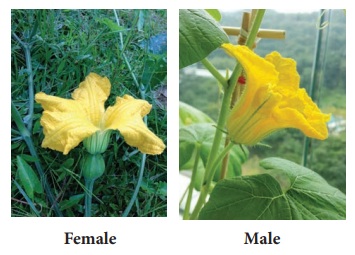
Choose three to four male flowers. Pluck the stamens of these flowers and dust the the pollen grains in a sheet of paper and collect it. Open five out of ten bags containing female flowers. Brush the collected pollen grains on the stigma with a soft paint brush. Take care not to damage the stigma. After few days we can see that flower in all bags that were not opened at all would wilt without forming a fruit, while most of the flowers to which pollens have been applied for fruits.
The process by which pollen grains reach stigma is called as pollination. The flower that receives pollen grains is called pollinated flower while the one that did not receive pollen grains is called as unpollinated flower.
4. Pollination
In the above experiment we transferred the pollen grains from male flower to the female flower. This is called as an artificial pollination. However in naturethere are many ways in which pollen grains reach the stigma of the flower and is called as natural pollination.
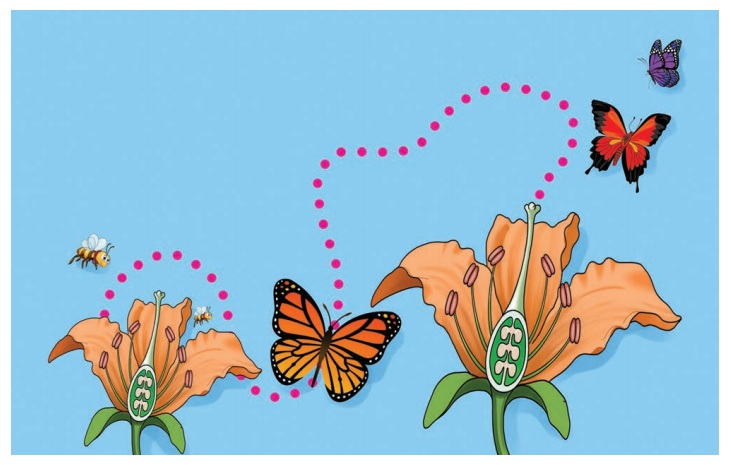
In some plants like grasses, pollen grains are light. Stamens shed pollen grains, and are carried by wind to other flower. Insects, birds are also other agents of pollination. Bees, butterflies and variety of birds hover around flowers. They help to carry pollen from one flower to another. Pollen grains stick to their legs, wings or abdomen when they move from one flower to another. This is called as Cross pollination
When you shake stamens, pollen grains fallout. Thus when a wind shake the flower or when a butterfly agitate the flower, pollen grains could fall onto the stigma of same flower. Some plants that have both the male and female parts within a single flowers(bisexual) pollinate by this means. This is called as Self pollination.
Beans (Fabaceae), tomatoes (Solanaceae) are commonly self-pollinate. Even though, for example tomato, self pollinate, they need the help of the insects to create vibrations within the flowers that will effectively loosen the pollen.
Paddy is mostly self pollinating using just gentle wind as the pollinating agent. The agents that are helping in pollination are called pollinators.
Differences between Self / Cross Pollination.

Self Pollination
• Pollen grains are transferred from the anther to the stigma of the same flower or to another flower of the same plant.
• Plants do not need to produce pollen grains in a large quantity for self pollination
• It does not produce changes in the characteristics of new plants.
Cross Pollination
• Pollen grains are transferred from the anther of one flower to the stigma of another flower of the same kind or different plant.
• Plants need to produce pollen grains in larger quantities to increase the chance of pollination.
• Cross pollination does introduce variations in characteristics of new plants.
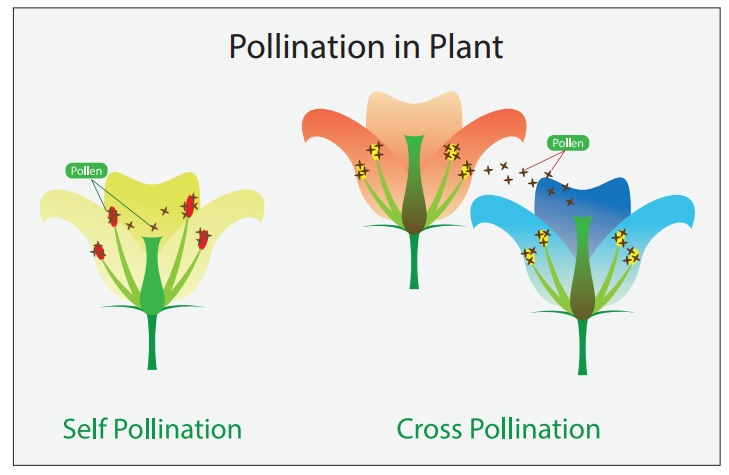
In many plants, pollens have to come from some other flowers. This is obvious in case of plants which have distinct male and female flowers like pumpkin. In some flowers the gynoecium matures first before the androecium shed pollens. Plants such as apples, plums, strawberries, pumpkins use insects for cross-pollination.
5. Fertilization
Through pollination, pollen grains reach stigma. What happens to them after this? Substances produced on the stigma causes the pollen grain to germinate. During the germination a tube develops from the pollen grain that carries male gametes that ultimately reaches female gamete inside the ovary through the style. Male gamete fuses with the female gamete to form zygote. This process is knows as fertilization.
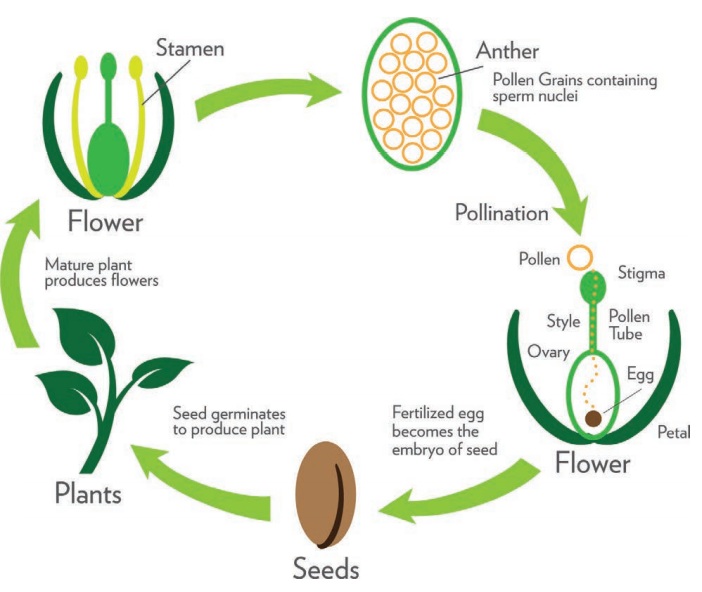
Life cycle of a plant
Where is this female gamete? Inside the ovary, small rounded structures, ovules are present. In these ovules, female gamete is present. To know more about this, we should cut ovary of a flower in longitudinal and transverse ways.

Cut a ovary of a flower both vertically and horizontally. Observe the ovules. Compare the ovary and ovules from few different flowers. Are there one or more ovules? Can you see any connection between the number of ovules in the ovary and number of seeds in each fruit?
Collect some fruits – Tomato, Brinjal, Lady’s finger (vegetable), mango, peas and custard apple and observe. You can see some green part above brinjal and lady’s finger. what are they?
Compare mango, custard apple and peas. All these are single fruits but custard apple has many small parts in it, each with a seed. Mango has a single seed and pea has many seeds. What do you understand from the above observations?
i. A green part above fruits of brinjal and lady’s finger are sepals of a flower. In some, after fertilization, sepal will not fall from fruit and remain or persist with fruit.
ii. Custard apple : It is made up of many fruits, aggregated together. Each fruit part is thin, membraneous with some granule like, which is edible.
iii. Mango : Outer skin and middle pulpy are edible and sweet. Inner most is with single seed.
iv. Pea : Fruit is not fleshy, but forms a covering pouch for many seeds.
In all above fruits, ovary, a lower most swollen part of pistil develops into a fleshy fruit. Ovules present inside the ovary gets transformed into a seed.
Hence, now with these observations, shall we list the changes taken place in a flower after fertilization. These are collectively said to be post fertilization changes and are:
* Calyx sometimes persist with fruit
* Petals wither / fall off
* Androecium fall off.
* Pistil remain and develops into a fruit.
* Style and stigma fall off
* Ovary enlarges to store food materials and develops into a fruit.
* Ovules present inside the ovary develops into seeds.
1. The world’s largest and heaviest seed is the double coconut. The seed looks liketwo coconut fused together. It only grows in two islands of the Seychelles. A single seed may be 12 inches long, nearly 3 feet in circumference and weighs about 18 kg.
2. Orchids have the smallest seeds in the plant kingdom. 35 million seeds may weight only about 25 gram.
Related Topics